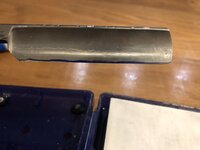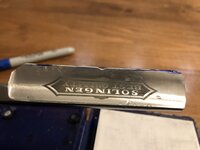Hi there,
New to the forum and to straight razor shaving. I have been lurking and reading lots on the internet, however I have not been having success with the honing process. I have also not been able to find anything definitive to help me move forward.
Long story short, I was given a “Solingen Best Quality” straight razor a few years ago. I shaved with it, without stropping, until it was too dull to shave comfortably. I only recently pulled it out again as I had come to terms that I would have to spend money to upkeep it.
Not being able to find anyone locally to hone it for me (BC, Canada) I spoke with a fellow at Sharpening Supplies.com who advised me that in my situation I would need a Norton 4K/8k wetstone, as well as a strop and green compound. I bought and received them a week or so about.
I originally (edit: removed lapped) honed my blade at 8k before stropping, however it failed the HHT as well as the shave test. I went down to 4K, honed for quite a while, moved my way back up, and again the same results. I’ve stayed at 4K and have had no results.
I thought I should do the magic marker test as perhaps my stone was uneven. I found my blade was wearing different on one side than it was on the other, which leads me to believe that perhaps it is blade geometry.
Any advice on how to remedy this? I have posted photos of my MMT results for your consideration.
Thank you,
Sarge438
New to the forum and to straight razor shaving. I have been lurking and reading lots on the internet, however I have not been having success with the honing process. I have also not been able to find anything definitive to help me move forward.
Long story short, I was given a “Solingen Best Quality” straight razor a few years ago. I shaved with it, without stropping, until it was too dull to shave comfortably. I only recently pulled it out again as I had come to terms that I would have to spend money to upkeep it.
Not being able to find anyone locally to hone it for me (BC, Canada) I spoke with a fellow at Sharpening Supplies.com who advised me that in my situation I would need a Norton 4K/8k wetstone, as well as a strop and green compound. I bought and received them a week or so about.
I originally (edit: removed lapped) honed my blade at 8k before stropping, however it failed the HHT as well as the shave test. I went down to 4K, honed for quite a while, moved my way back up, and again the same results. I’ve stayed at 4K and have had no results.
I thought I should do the magic marker test as perhaps my stone was uneven. I found my blade was wearing different on one side than it was on the other, which leads me to believe that perhaps it is blade geometry.
Any advice on how to remedy this? I have posted photos of my MMT results for your consideration.
Thank you,
Sarge438
Attachments
Last edited:




